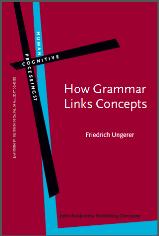|
||||||||
 |
How Grammar Links Concepts Friedrich Ungerer The proposed framework of concept linking combines insights of construction grammar with those of traditional functional descriptions to explain particularly challenging but often neglected areas of English grammar such as negation, modality, adverbials and non-finite constructions. To reach this goal the idea of a unified network of constructions is replaced by the triad of verb-mediated constructions, attribution and scope-based perspectivizing, each of them understood as a syntactically effective concept-linking mechanism in its own right, but involved in interfaces with the other mechanisms. In addition, concept linking supplies a novel approach to early child language. It casts fresh light on widely accepted descriptions of early two-word utterances and verb islands in usage-based models of language acquisition and encourages a new view of children’s ‘mistakes’. Intended readership: Constructionist and cognitive linguists; linguists and psychologists interested in language acquisition; teachers and students of English grammar and grammar in general. JOHN BENJAMINS PUBLISHING COMPANY |
|||
Table of contents Chapter 1. Introduction Part 1. Basics Chapter 2. Mechanisms of concept linking Chapter 3. Hierarchy in concept linking Chapter 4. Restrictions on concept linking Chapter 5. Signaling concept linking Chapter 6. Concept linking, topic, comment and focusing Part 2. Interfaces Chapter 7. Introductory remarks on interfaces in concept linking Chapter 8. Interfaces of verb-mediated constructions and attribution Chapter 9. Interfaces of perspectivizing and attribution (adverb interfaces) Chapter 10. Non-finite constructions as interfaces of VMCs, attribution and perspectivizing Chapter 11. Interfaces and the grammaticalization of perspectivizers Part 3. Language acquisition Chapter 12. Introductory remarks on concept linking in language acquisition Chapter 13. Temporal priority of attribution in early language acquisition Chapter 14. The emergence of VMCs and copula/modifier interfaces Chapter 15. The development of perspectivizing mechanisms Chapter 16. Conclusion and outlook |
||
|
|
||||||||||||||||||||||||||||||||
Last update: May 2019 |
||